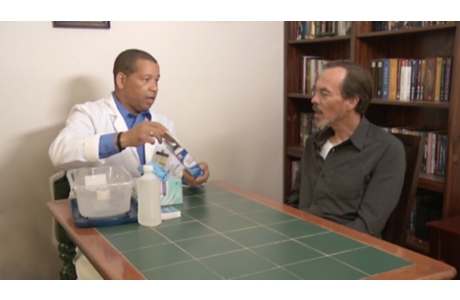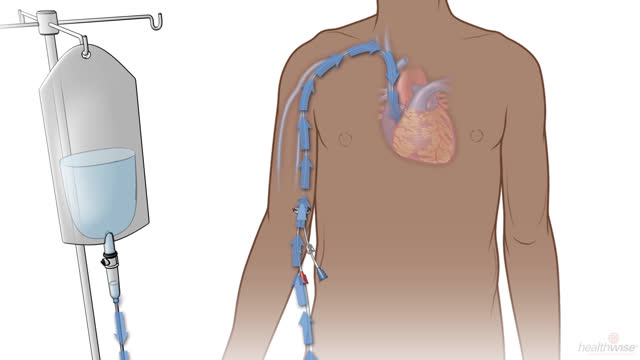Central Vascular Access Device (CVAD)
Make an Appointment
Our team is here to help you make an appointment with the specialists that you need.
Central Vascular Access Device (CVAD)
Overview
What is a central vascular access device (CVAD)?
A CVAD is a thin, flexible tube. It's also called a central line. It is used when a person needs to receive medicine, fluids, nutrients, or blood products for several weeks or more. It's often placed in the neck, chest, or arm.
Why is it used?
CVADs are used to:
- Give long-term medicine treatment for pain, infection, or cancer, or to supply nutrition. A CVAD can be left in place far longer than an intravenous catheter (I.V.), which gives medicines into a vein near the skin surface.
- Give medicines that affect the heart, especially if a quick response to the medicine is wanted.
- Give large amounts of blood or fluid quickly.
- Receive kidney dialysis if you have kidney failure.
A CVAD may be used to draw blood for tests only if another vein, such as in the hand or arm, can't be used.
It may also be used to check blood flow in the heart and body.
What are the types of central vascular access devices?
There are several types of CVADs.
- PICC line.
A peripherally inserted central catheter, or PICC line (say "pick"), is a CVAD inserted into a vein in the arm rather than a vein in the neck or chest.
- Tunneled catheter.
This type of catheter is surgically inserted into a vein in the neck or chest and passed under the skin. One end of the catheter remains outside the skin. Medicines can be given through an opening in this end of the catheter. Passing the catheter under the skin helps keep it in place better, lets you move around easier, and makes it less visible.
- Implanted port.
This type is similar to a tunneled catheter but is left entirely under the skin. Medicines are injected through the skin into the catheter. Some implanted ports contain a small reservoir that can be refilled in the same way. After being filled, the reservoir slowly releases the medicine into the bloodstream. An implanted port is less obvious than a tunneled catheter and requires very little daily care. It has less impact on a person's activities than a PICC line or a tunneled catheter.
What are the risks?
Possible risks from the use of a CVAD include:
- Bleeding, caused by inserting it into the vein. But this is usually mild and will stop by itself.
- Infection, requiring treatment with antibiotics or removal.
- Blood clots, which can form in blood vessels, especially in the arms.
- A blocked line. This can happen from a blood clot or from something else getting stuck in the line. Regular flushing of the CVAD can help keep the line clear. Preventing infections and making sure it is in place can also help keep the line clear.
- Kinking. A twisted or kinked CVAD must be repositioned or replaced.
- Pain. You may feel pain at the place where it is inserted or where it lies under your skin.
- Collapsed lung (pneumothorax). The risk of a collapsed lung varies with the skill of the person inserting the CVAD and the site of placement. It is most likely to happen during placement in the chest. But the risk is small.
- Shifting. If the CVAD has moved out of place, it can sometimes be repositioned. If that doesn't work, it must be replaced.
How can you care for a central vascular access device at home?
You can take the following steps at home to care for your CVAD.
- Always wash your hands before you touch your central line.
- Try to keep the exit site dry.
This can help prevent infection. When you shower, cover the site with waterproof material, such as plastic wrap. Be sure you cover both the exit site and the central line cap(s).
- Fasten or tape the central line to your body.
This can prevent it from pulling or dangling.
- Avoid bending or crimping your central line.
- Wear clothing that doesn't rub or pull on your central line.
When should you call for help?
Call 911 anytime you think you may need emergency care. For example, call if:
- You passed out (lost consciousness).
- You have severe trouble breathing.
- You have sudden chest pain and shortness of breath, or you cough up blood.
- You have a fast or uneven pulse.
Call your doctor now or seek immediate medical care if:
- You have signs of infection, such as:
- Increased pain, swelling, warmth, or redness.
- Red streaks leading from the exit site.
- Pus or blood draining from the exit site.
- A fever.
- You have a fever or you have chills.
- You have swelling in your face, chest, neck, or arm on the side where the central line is.
- You have signs of a blood clot, such as bulging veins near the line.
- Your central line is leaking.
- You feel resistance when you inject medicine or fluids into your line.
- Your central line is out of place. This may happen after severe coughing or vomiting, or if you pull on the central line.
Watch closely for any changes in your health, and be sure to contact your doctor if:
- You have any concerns about your central line.
Credits
Current as of: July 31, 2024
Author: Ignite Healthwise, LLC Staff
Clinical Review Board
All Healthwise education is reviewed by a team that includes physicians, nurses, advanced practitioners, registered dieticians, and other healthcare professionals.
Current as of: July 31, 2024
Author: Ignite Healthwise, LLC Staff
Clinical Review Board
All Healthwise education is reviewed by a team that includes physicians, nurses, advanced practitioners, registered dieticians, and other healthcare professionals.
This information does not replace the advice of a doctor. Ignite Healthwise, LLC, disclaims any warranty or liability for your use of this information. Your use of this information means that you agree to the Terms of Use. Learn how we develop our content.
To learn more about Ignite Healthwise, LLC, visit webmdignite.com.
© 2024-2025 Ignite Healthwise, LLC.
This information does not replace the advice of a doctor. Ignite Healthwise, LLC, disclaims any warranty or liability for your use of this information. Your use of this information means that you agree to the Terms of Use. Learn how we develop our content.




